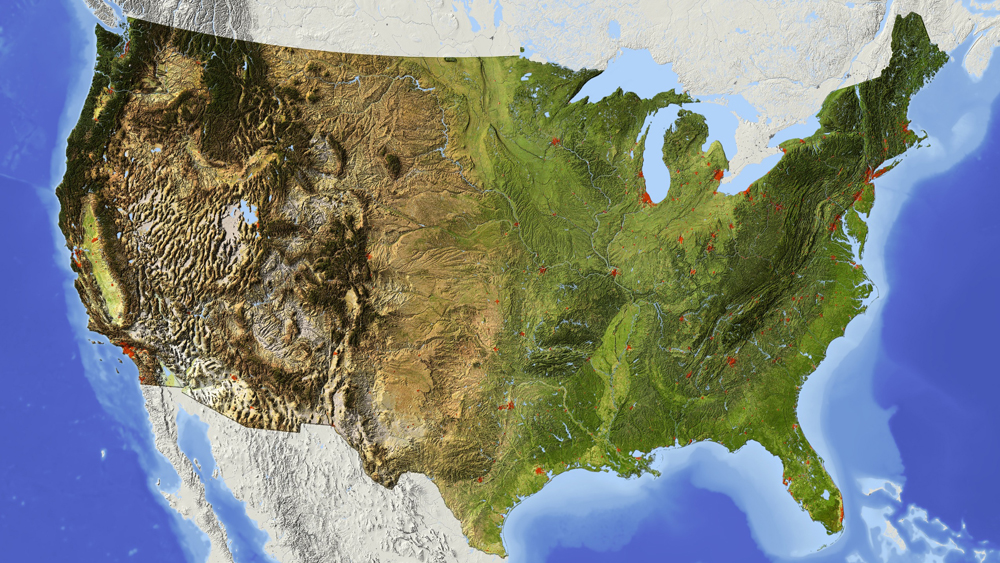
The following is a report on the US economy, by MFAT. The original is here.
New Zealand-US bilateral trade has continued to trend upwards over the past year. The US surpassed Australia to become New Zealand’s second largest export market in the year ending March 2024, behind China and ahead of Australia and Japan. In the year ending March 2024 New Zealand exported NZ$14.6 billion in goods and services to the US and imported NZ$11.4 billion, representing a trade balance of NZ$3.5 billion and a total trade value of NZ$25.8 billion[1].
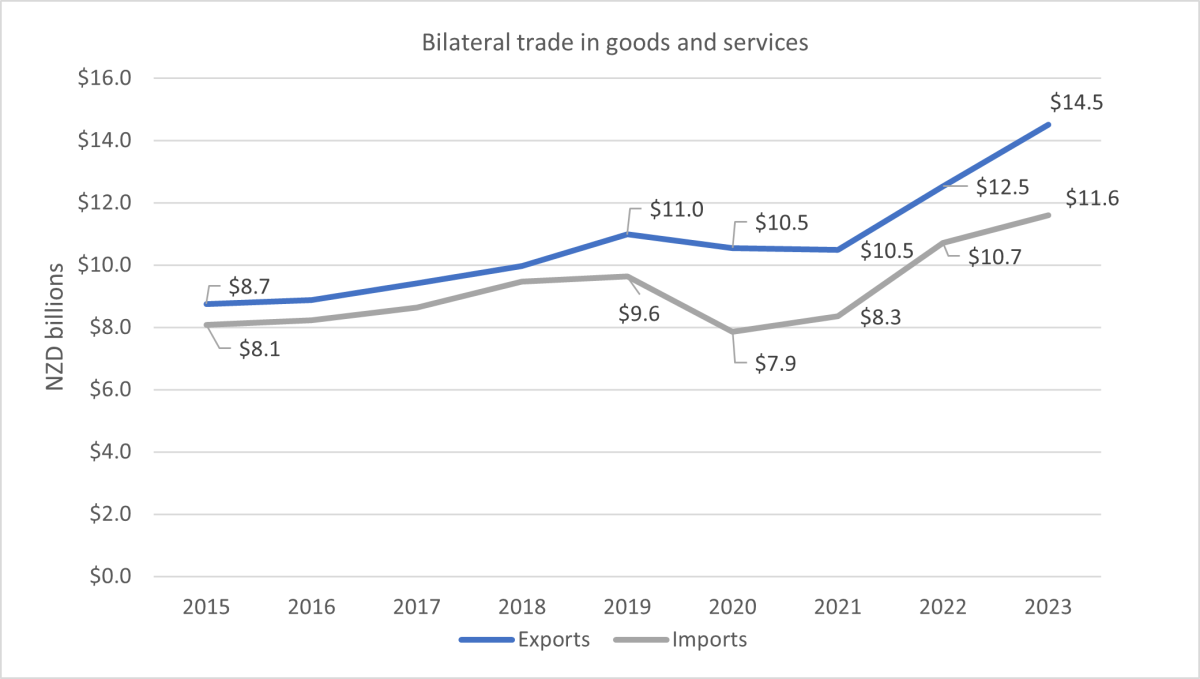
New Zealand exports to the US have followed a steady growth trajectory. COVID-19 interrupted that trend, but the post-pandemic rebound has seen a strong bounce-back. Exports grew by 16% to a new high of NZ$14.5 billion in 2023.
Unlike the overall export figures for New Zealand in 2023 which saw goods export growth fall and services increase, both goods and services exports to the US grew. Goods growth was a solid 5.8% though services enjoyed particularly strong growth of 32%.
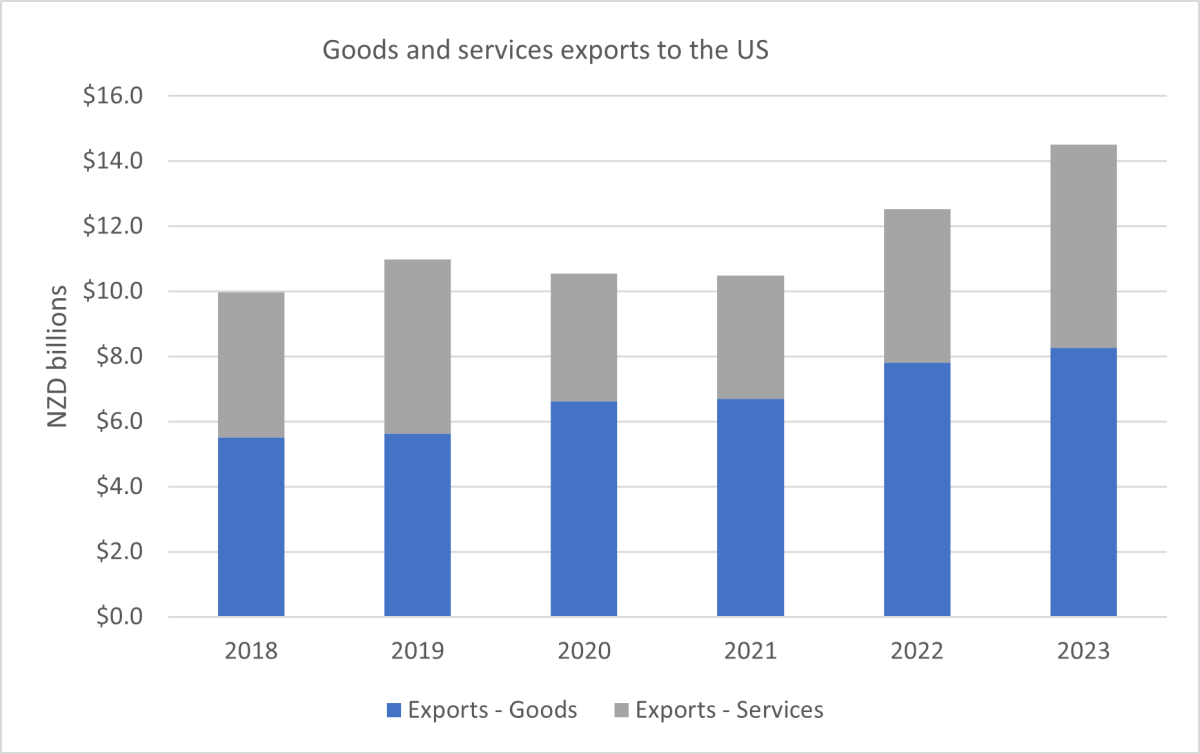
What’s driving this?
Services
The US is New Zealand’s top export market for services. At NZ$6.2 billion they accounted for around 23% of New Zealand’s total services exports in 2023 and grew by 32.2% that year.
The value of US travel exports has helped drive the post-pandemic recovery. Boosted by New Zealand’s hosting of major events like the FIFA Women’s World Cup, passenger numbers were up 159% in 2023 and by the end of 2023, visitor arrivals from the US were back up to 92% of pre-pandemic levels. Figures for 2024 also appear to be tracking strongly so far; January visitor arrivals were up by around 28% compared to pre-pandemic January 2019.
It is an exciting period for air connectivity between New Zealand and the US, with a number of new flight services commencing in 2023. During peak season there are almost 40 direct flights per week between California and New Zealand, and United Airlines’ flight from San Francisco to Christchurch is the first by an American airline to fly non-stop between the South Island and the United States.
Other services exports picked up significantly during the pandemic, including telecommunications, computer and information services (growing by 80% since 2019) and other business services (i.e. consulting services and research and development) (growing by 62% since 2019). Growth in these services tapered off last year but still reached a new combined high of NZ$1.6 billion.
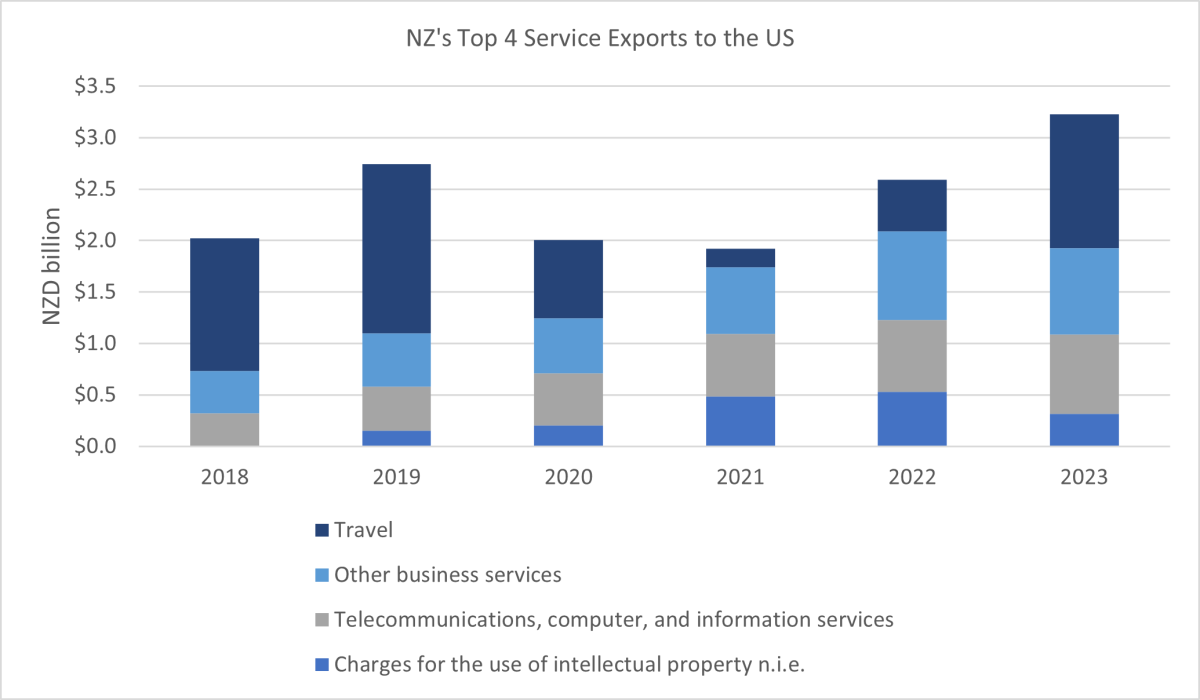
Goods
The US is New Zealand’s third largest market for goods exports. Goods exports were valued at NZ$8.3 billion in 2023, growing by 5.8% that year. Trade in goods for the first quarter of 2024 seems to be following this growth trend, increasing by 14% compared to the same period in 2023. This growth is mainly due to higher exports of dairy and meat in February 2024.
Primary sector products dominate the goods export portfolio. The US is the second largest market for the primary sector; behind China and increasingly ahead of Australia.
Meat exports to the US grew by 15% last year to a high of NZ$2.2 billion, the majority of this is beef exports which benefitted from record US market prices and grew by 27% to NZ$1.5 billion last year. Exports to the US helped to offset much lower demand from China. Strong US demand for beef is projected to continue because of further slowing of cattle slaughter, fifty-year lows in US beef cattle inventory and large demand for lean beef which will be heavily reliant on imports.
The US remains New Zealand’s number one export destination for wine, worth NZ$797 million in 2023. After Italy and France, New Zealand is the largest supplier of wine to the US. However, growth stagnated in 2023 after strong year on year growth averaging around 9% over the past 5 years. New Zealand Wine Growers President Philip Gregan has said that destocking of supply chains was a major dynamic affecting wine exporters across the globe in the second half of 2023 and it appears New Zealand Sauvignon Blanc exports to the US weren’t insulated from this.
The value of dairy exports to the US hit a high of NZ$1.2 billion in 2023. This is in comparison to total New Zealand dairy exports which fell in 2023. US consumer and producer demand for specialised milk protein products has continued to increase, this provides opportunities for New Zealand dairy exporters in both traditional and emerging protein categories.
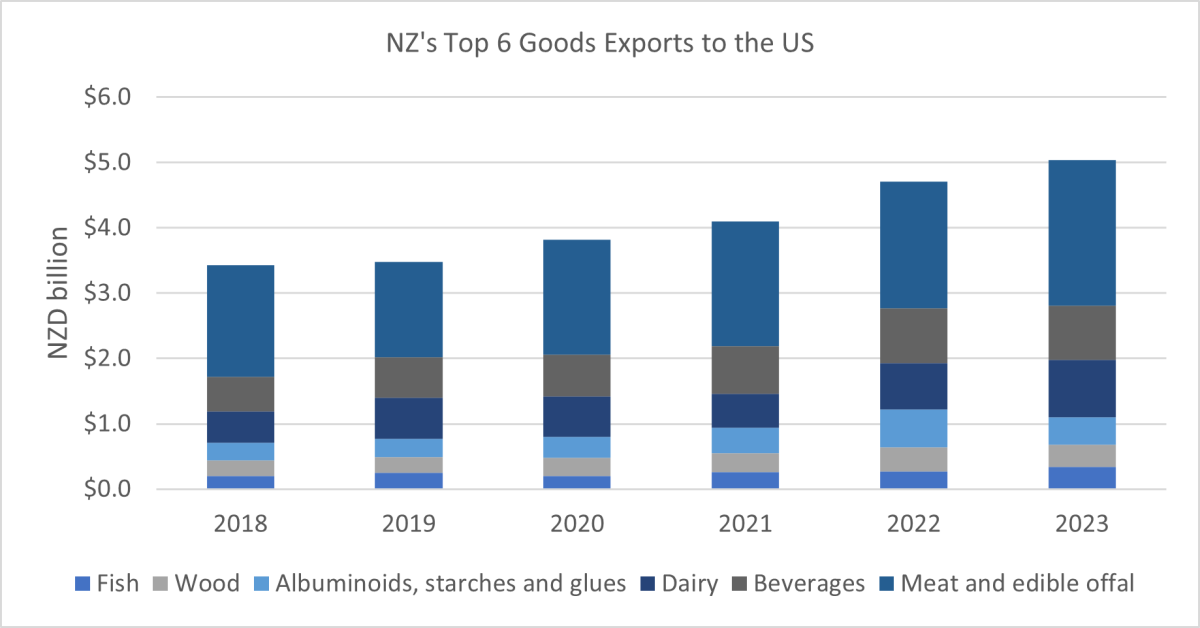
Manufactured goods exports also performed well in 2023, for example, NZ$644 million in mechanical machinery products. These exports typically build off New Zealand’s primary sector expertise, for example harvesting machinery.
Increasingly non-primary sector goods exports also include a range of high-tech goods, for example electro-magnets (NZ$107 million), electrical transformers (NZ$99 million) and machines for making semi-conductors (NZ$32 million).
Notably, over the past year, the value of the New Zealand dollar been relatively low against US dollar, at average of 61 cents. The lowest average since 2008. A high US dollar coupled with solid economic growth over the last three years has benefited New Zealand exporters.
Imports
New Zealand imported NZ$11.6 billion in goods and services from the US in 2023, growing by 8.3% and accounting for around 13% of total imports.
In 2023 New Zealand’s goods imports from the US were NZ$7.6 billion. These imports are concentrated in the aerospace sector, for example mechanical machinery (turbo-jets and turbo-propellers) and aircraft and aircraft parts valued at NZ$2 billion.
Notably, imported goods from the US for the first quarter of 2024 have decreased by 25% compared to the same period in 2023. This decline is mainly because there have been fewer imports of aircraft and aircraft parts.
Similar to services exports, New Zealand imports of services from the US are concentrated in travel, and telecommunications and computer services.
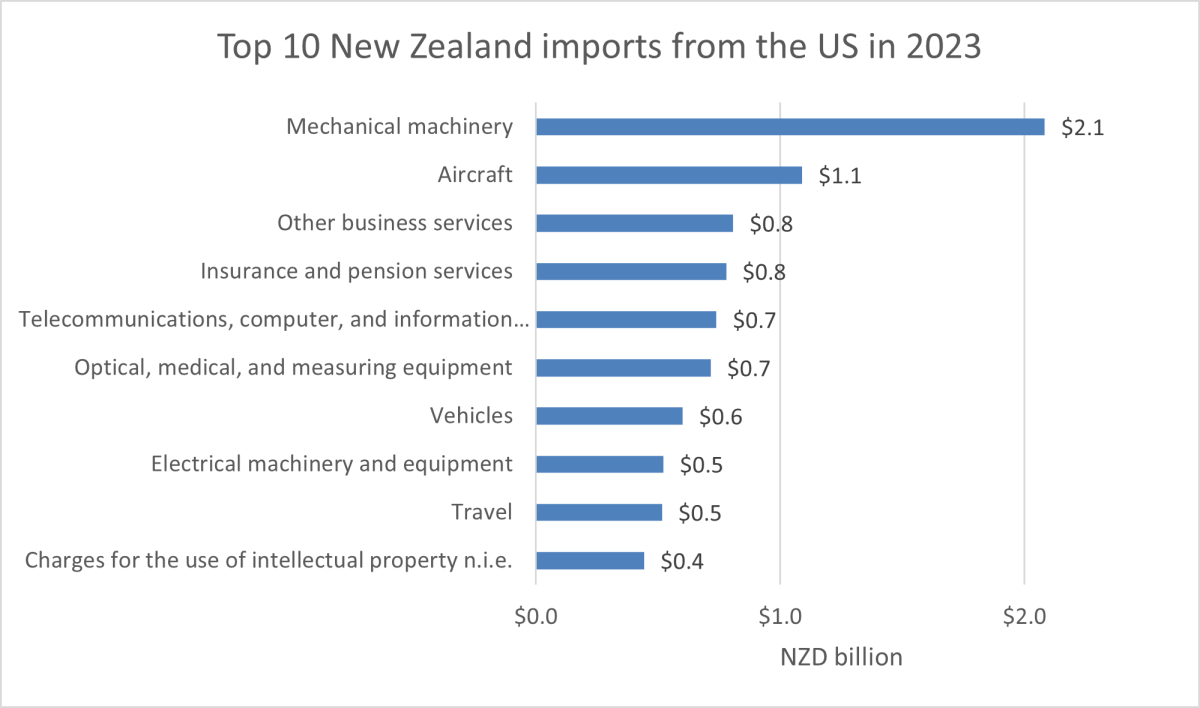
Bilateral investment continues to grow
The US is New Zealand’s third largest source and destination of foreign direct investment. In the year to March 2023, the US held a total stock of investment of NZ$64.6 billion in New Zealand, or 18.8% of the total investment stock. The bulk of this is portfolio stock (NZ$42.2 billion).
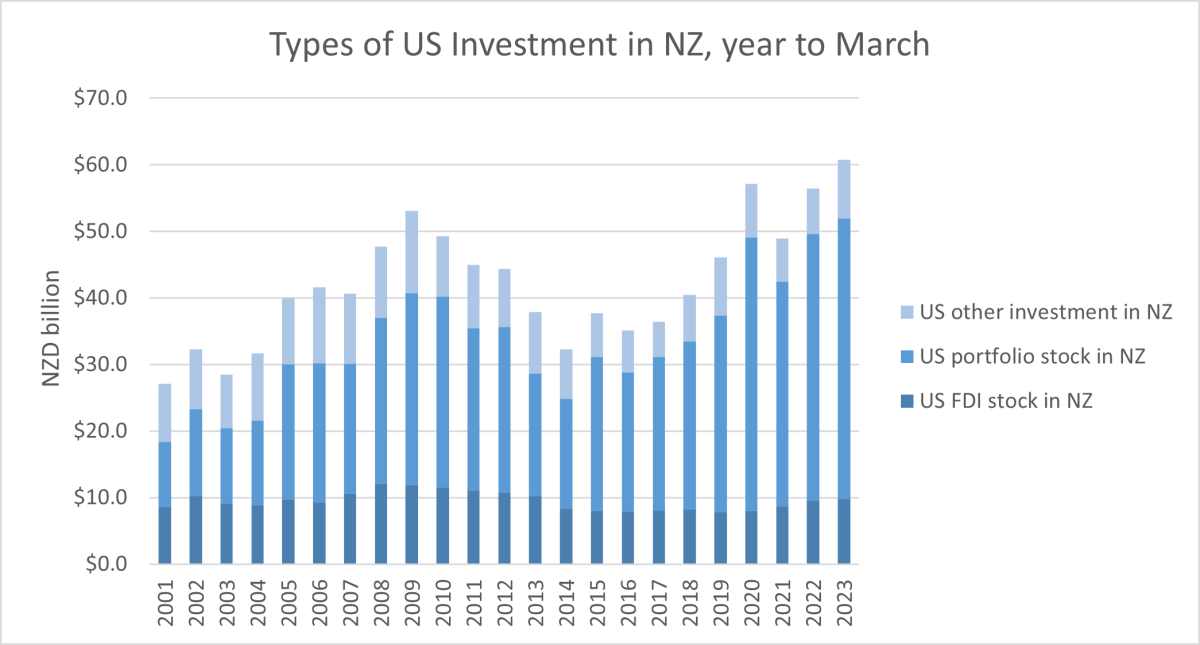
The value of New Zealand’s investment stock in the US also continues to grow. While the bulk of this investment is in portfolio stock, there are frequent examples of New Zealand companies investing in niche services, agriculture and manufacturing activities in the US.
The value of New Zealand investment also differs from State to State, for example New Zealand is the 6th largest foreign investor in Colorado – a number of New Zealand tech and aerospace companies have chosen to establish US operations from Colorado.
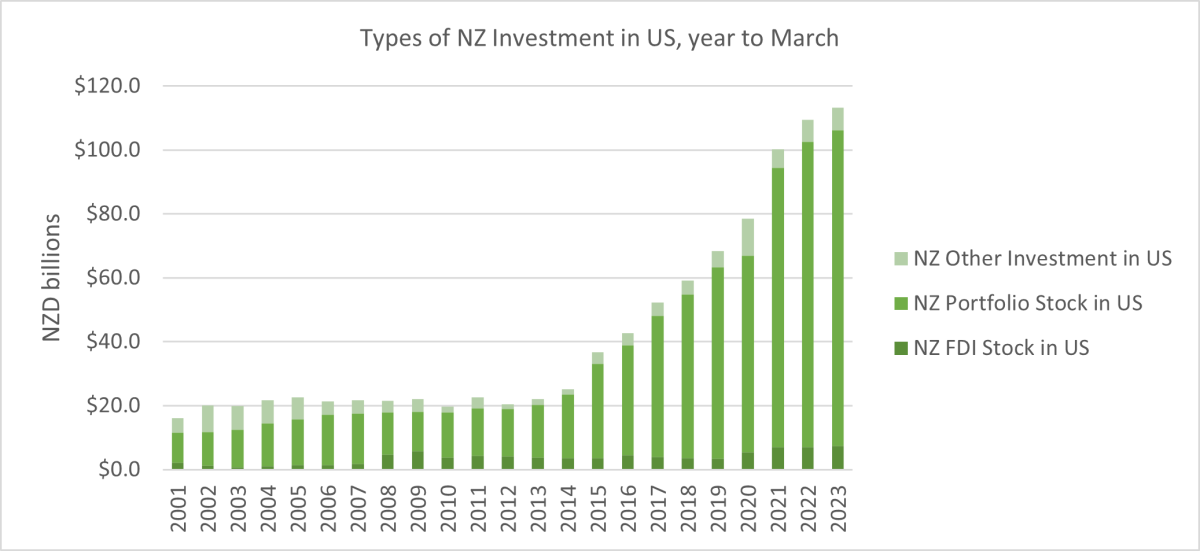
Footnotes
1. Figures used in this analysis have not been adjusted for inflation. However, previous analyses of the post pandemic recovery have concluded that the nominal recovery is more than just inflation. For example, Sense Partners NZ-US Trade & Investment Relationship Report(external link) that used June 2023 trade data adjusted for inflation concluded that both nominal export and import values have recovered and are largely above pre-pandemic levels.
2. Dairy (whey and milk constituents, butter and dairy spreads, milk powder, cheese, and albuminoids (casein, and peptones))
4 Comments
Meat exports to the US grew by 15%
This is sure to keep improving as more people become educated about meat consumption and its enormous benefits for human health.
..large demand for lean beef which will be heavily reliant on imports.
Keep an eye on the fatter cuts of meat too as the fear of animal fats subsides in the years to come.
For the vast majority of people who try it, the switch to a meat based diet is transformational. Word is quickly spreading and it is a very easy thing for people to try out. Meat exports have a great future.
Many people enjoy eating meat, for sure, but "it's enormous benefit for human health"? Maybe you could share some data on that?
We are seeing the meat heavy diets gaining in popularity mainly due to self reported results and the ease of communicating these results in the modern world. A quick search on YouTube will reveal a plethora of YouTubers all reporting wide ranging health improvements. Commenters on these videos are all overwhelmingly positive with their feedback.
This is not going unnoticed and with so many people suffering greatly from obesity, type 2 diabetes, arthritis, dementia and mental issues, all immune system or food related. The possibility of improving overall immune system health is high on people's wish lists. The list of self reported health benefits is surprisingly high, although not so surprising when you consider that the diet is improving the overall health of the human body. Many people report dropping most of their medications for metabolic disorders after being on a meat based diet for a few months.
High meat diets and for some people 100% meat diets are, unfortunately, more available to those living in wealthy societies. Wikipedia describes the carnivore diet as one for "select elites". The US is such a society and luckily we already have our foot in the door of that market. Therefore I am confident in a significant uptick in exports as this diet trend grows.
Grass fed meats are high on the list of the best meats available due to the animals eating their ancestrally appropriate food and NZ can supply a lot of this. We are well poised to meet this market.
I'm kind of passionate about a mostly meat diet as I follow this regime myself. I'm 64 with no health issues, take no medications, never got COVID, slim and fit. I walked 12km today before 10am. A primary motivation for me is how it makes me feel mentally. If I fall of the wagon I can feel anxiety and depression start to creep in. Yet when fully committed I'm noticeably well balanced and calm. My response to people's health disorders these days is always, "Eat mostly meat!"
I'm also very keen on studying human evolution and found this particularly compelling evidence that we humans are and are supposed to be hyper-carnivores:
The evolution of the human trophic level during the Pleistocene
The really interesting graph is the last one - NZ Investment in USA. It mirrors the rise and rise of Kiwisaver funds. Assuming a 5% return per annum its going to, or has, overtaken the export goods return and is pure yield on invested funds and not gross returns.
Goods etc are important but will, in time, be completely over shadowed by returns on capital invested - just look at the rate of increase in that class versus actual goods.
In time NZ will become a wealthy country.

We welcome your comments below. If you are not already registered, please register to comment.
Remember we welcome robust, respectful and insightful debate. We don't welcome abusive or defamatory comments and will de-register those repeatedly making such comments. Our current comment policy is here.